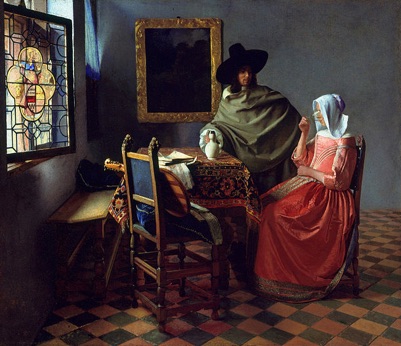The Wine Glass


Vermeer was about 27 when he painted The Glass of Wine, which may be considered one of Vermeer's first fully mature works.
The scene likely represents some type of courtship, but the roles being played by the two figures are not clear. The woman has just drained the glass of wine and the man seems impatient to pour her more, almost as if he is trying to get her drunk. A musical instrument, the cittern, lies on the chair with musical notebooks. But the figure of Temperance is depicted in the stained glass window, adding to the tension in the scene.
Compared to his earlier paintings, Vermeer's brushwork in The Wine Glass is subdued, while the faces and clothes of the figures are depicted with wide smooth outlines. Only in the tapestry of the tablecloth and the window glass did the artist apply finely detailed, linear brush strokes. At the time Vermeer was not the only Dutch artist attempting to develop the ideas of De Hooch; contemporary paintings from Jan Steen, Gerard Ter Borch, and Frans van Mieris the Elder also display a refined technique.
The painting shares elements with other Vermeer works. The Girl with the Wine Glass (1659–1660) portrays two men, but in common with The Wine Glass it has a woman seated at a table with a glass of wine, and the tiled floors and stained-glass windows in both are very similar. The same wine pitcher appears in an earlier Vermeer, A Girl Asleep (1657).
The Wine Glass is a transitional work, and as such, is not commonly viewed as one of Vermeer's finest.
Artist:
Johannes Vermeer
Year:
1658 - 1659
Type:
Oil of Canvas
Dimensions:
26.12 in × 30.12 in
Location:
Gemäldegalerie
Berlin, Germany
EARLIER PAINTING
NEXT PAINTING

Other Artists
About this Painting

